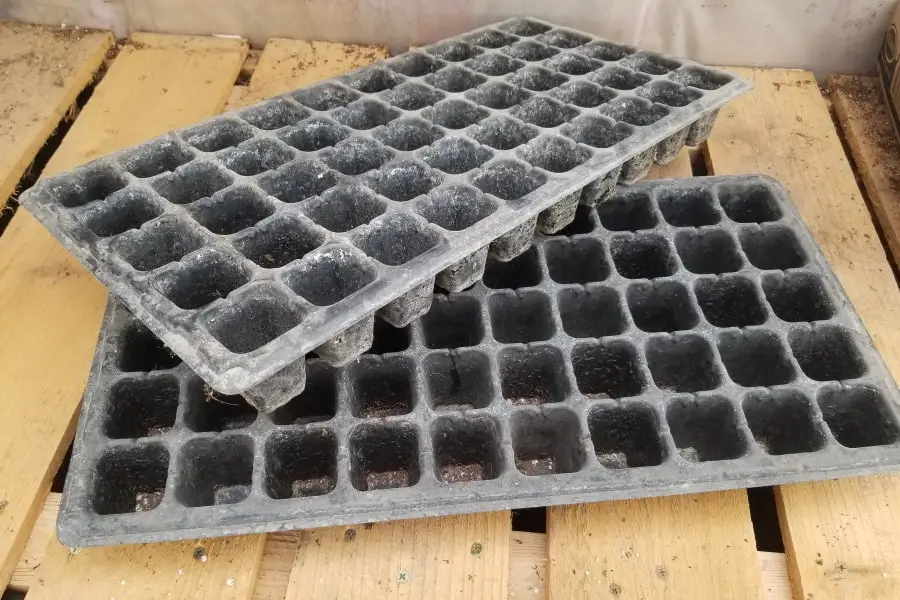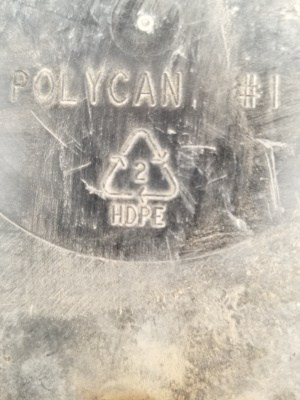
Reduce, reuse and recycle. Going green all the way? Taking responsibility for the waste we create is important to our quality of life, our future, and our future generations. Before we purchase something, we should be asking ourselves: is any of this recyclable? And when it comes to our summer gardening, ideally, we aren’t creating more waste in our efforts to grow fresh food.
Plastic seed trays are typically made out of recyclable materials. The more complex question that we need to answer would be, “are they recyclable in your neighborhood,” and “what is the plastic code that is printed on your tray?” Not all plastics are deemed acceptable for recycling. You can find out the exact answers by contacting your local recycling facility.
How can you tell the difference from something that belongs in the recycle bin vs. a regular piece of trash that belongs in the garbage bin? Use your green thumbs to scroll through this informative lesson on plastics and recycling!
Reading the Fine Print on Your Plastic Seed Trays
If you are not 100% sure if your seed tray – or any plastic item – is recyclable, how do you find out the answer? When a recyclable container is manufactured, you will find a set of three arrows forming a triangle, usually green in color. A number stamped on the bottom/back of the packaging signifies the category it belongs to.
Even though the item may “technically” be marked safe for recycling, you will need to do your homework to see if certain materials are accepted where you live. Recycling facilities are not all the same, and not all are equipped to handle every material that is recyclable.
With that said, most recycling plants do accept plastics, since they are the most commonly recycled materials. Still, check that code on your seed tray, as some trays may be made with a blend of materials other than plastic.
Before You Recycle Your Seed Trays
Before you recycle, think about the other two R’s : reuse and repurpose. you may be able to get some more life out of your seed trays:
- Use your seed trays for another season
- Find a friend who needs them
- Give them away from free on social media
- Donate them to a garden center
- Clean them up and use them to organize and store something
If you know it’s the end of the line for your seed trays; then it is time to recycle. And, if this is really important to you,
Preparing Your Seed Trays for Recycling
So, you will most likely be able to recycle your plastic seed trays, but you should make sure to rinse them out first. As with anything else you might put in the recycle bin, always wash the items as a courtesy to the collection crew. This will also help to keep your bin clean, free from sticky mess, stench, and unwanted critters looking for food scraps.
Not all areas offer trash and/or recycling pick-up. If you have to take your garbage to a local dump or landfill, then you should be able to ask in person what you can and cannot bring to be recycled. This is your chance to ask if there is any special prep you should do. You don’t want to have your trays get rejected for not being ready for recycling.
Recycling note: There is a new rule that is starting to be widely enforced, which prohibits plastic bags in the recycle bins. They cause costly damage to sorting machines at the plants.
Consider returning them to your local grocery store, reusing them in your smaller trash cans, or switching over to canvas shopping bags to save you from the headache of how you are going to dispose of them.
Find Out Your City’s Specific Recycling Policy
Since not every municipality recycles the same items, you will have to check in with your neighborhood to get an accurate list of recyclable items allowed in your bins.
If you do not follow the rules and regulations, you could end up getting a fine or having your bin left behind on trash day. The collectors do not have time to sort through picking out the rejected items.
You can find out this info online or give your collection service a call. You may receive a list in the mail, as recycling facilities typically send annual reminders through the post. For counties that provide special recycling collection bins to the residents, there is often a label with a list of what is and what is not accepted.
Then you’ll be back to that number on the bottom/back of your seed tray. Check it to know what you’ll be able to do with it.
What Do The Recycling Codes on My Seed Tray Mean?

Let’s take a closer look at the plastic recycling codes and what they mean. The code is a number printed or stamped on the container and can be found with the recycle symbol: three arrows forming a triangle
There are many different types of plastics, and it is important to understand their differences, especially when it comes to recycling.
- 1: PETE (Polyethylene Terephthalate) Easiest to recycle. Used for Water bottles.
- 2: HDPE (High-Density Polyethylene) Commonly recycled. Used for detergent and soap bottles.
- 3: PVC (Polyvinyl Chloride) Difficult to recycle. Hazardous. Used for pipes.
- 4: LDPE (Low-Density Polyethylene) Can be recycled. Used for grocery bags
- 5: PP (Polypropylene) Can be recycled. Used for various bottles.
- 6: PS (Polystyrene) Difficult to recycle. AKA Styrofoam
- 7: OTHER Often, a mix of many plastics. Almost impossible to recycle.
Can You Recycle Seed Trays at the Garden Center?
Did you know that most garden centers and home improvement stores with nurseries will accept your used plastic seed trays? There will be no charge for bringing the trays; on the contrary, you may receive a small refund or discount.
It is not really about getting something back, though. Is it? If you decide to return your trays to the store, make sure they are in decent condition. That means checking for breakages, debris, and bugs. Give them a quick rinse with your garden hose and let them air dry before loading them up in your car.
If you are not sure if your local nursery will take them off of your hands? Give them a call to ask, let them know how many, and what size the trays are. They will be familiar with them, especially if you purchased your plants there.
Basics of Recycling
Are you wondering about the inner workings of a recycling plant/center/facility? Some plants actually have field trips and groups come in to take a tour. If your curiosity is strong enough, call up your local plant and ask if it is possible to schedule a tour.
See how it works from start to finish. You will see trucks pull up that have just gone on their rounds, collecting recyclable materials. The truck driver will dump the load onto a conveyor belt where the materials will be taken to get sorted further. Sorting may be done by machine, or by the hands of workers.
Once the materials have been properly sorted, they are compressed by machines and stored in a warehouse until they are ready to be shipped out to be processed into something new! Most of the time, our recyclables are sent overseas for the final processing. Though there are a few facilities that handle the entire process.
When dealing with cardboard or paper, they are typically shredded in-house before compressing into bundles.
Why Recycle Those Seed Trays?
Recycling may not be a new idea, but it is becoming more and more part of our daily lives. As we approach the point of becoming overrun by our own refuse, we are literally forced to think (and act) proactively about the impact our ignorance is causing.
Not only are we becoming more responsible about recycling our waste, but we are actively making an effort to produce less waste. And, finding ways in which we can recycle, reuse, and re-purpose the materials ourselves.
In short, your seed trays can go along way beyond single-use. Reuse, re-purpose, and, if your town permits, recycle!

